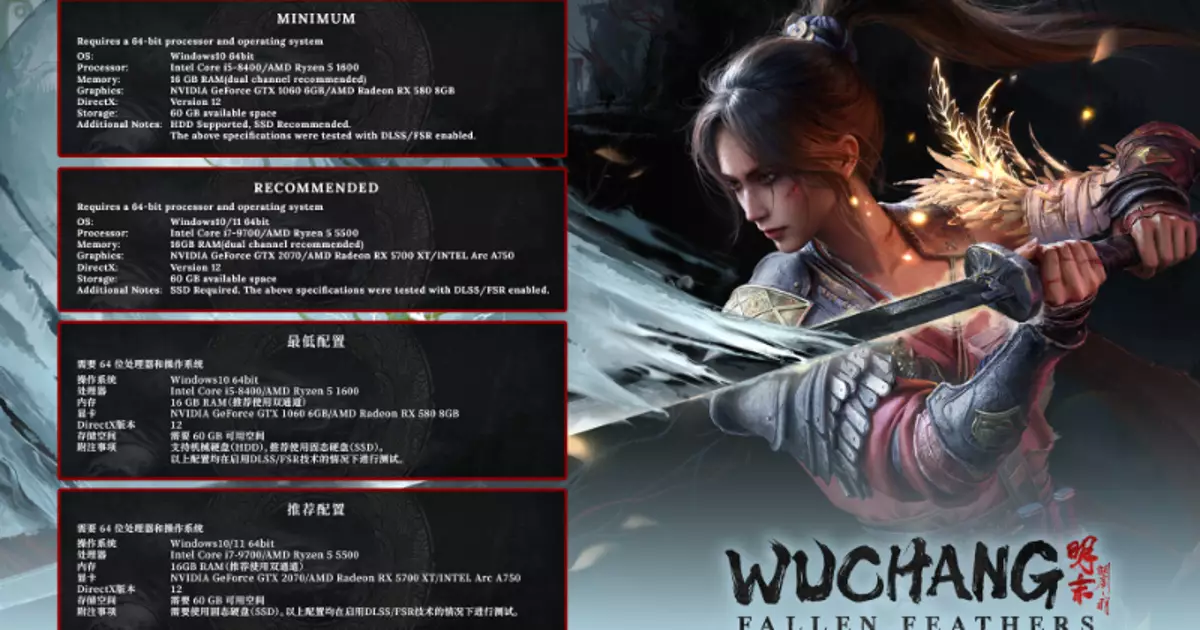Wuchang: Fallen Feathers promises to carve out a distinctive space in the crowded landscape of action role-playing games by blending folklore-inspired storytelling with high-octane combat. Unlike traditional Western RPGs that often lean heavily on medieval fantasy, this game immerses players in the tumultuous era of the Ming Dynasty within China, offering a fresh cultural perspective wrapped in a dark, atmospheric setting. Unlike many similar titles, Wuchang demonstrates that style need not come at the expense of accessibility; its system requirements suggest a title that is visually ambitious yet not overly demanding, opening doors for a broad range of players to experience its intricate world.
From a gameplay perspective, the game appears to be a thoughtful fusion of exploration, combat, and narrative choice. The player’s role as Wuchang, a pirate swordswoman suffering from a fantastical feathered plague, immediately evokes curiosity. Her quest to uncover her past while battling the monstrous effects of the disease creates an intriguing emotional hook that elevates the standard action-RPG formula. As she interacts with her environment and enemies, she gains access to a variety of techniques through “Red Mercury,” which hints at an innovative approach to weapon customization and combat mechanics. The emphasis on choice-driven storytelling with multiple endings adds significant replay value, encouraging players to experiment with different approaches and allies.
What sets Wuchang apart is its striking aesthetic evolution. Since its initial conception in 2021, developers Leenzee have refined the visual style, moving away from a blood-red, Bloodborne-esque atmosphere towards a less overtly ominous tone. Instead of a realm dominated by horror tropes, the game now offers a more balanced blend of boss fights, upgrades, and mythic storytelling rooted in Chinese folklore. This visual and thematic shift is promising as it signals a maturation of the game’s tone—more aspirational than sensational, yet still intense.
System Requirements: A Reflection of Ambition and Strategy
The system specifications for Wuchang are notable for their pragmatism. The minimum requirements are relatively accessible, demanding only a mid-range Intel Core i5-8400 or similar Ryzen 5 1600 CPU, 16 GB of RAM, and a GTX 1060 or RX 580 GPU. For players with a decent gaming rig, this means that enjoying the game’s visceral combat, intricate environments, and atmospheric storytelling is within reach without needing cutting-edge hardware.
However, for those seeking the most visually striking experience, the recommended specs push towards more powerful hardware, including an RTX 2070 or an RX 5700 XT graphics card and the mandatory use of an SSD. The mention of DLSS 4—Nvidia’s AI-driven upscaling technology—demonstrates that Wuchang is designed to harness modern graphics enhancements for improved performance and visual fidelity. This suggests that the developers are aiming for a balanced approach: providing visual richness that isn’t necessarily uncomfortable for players with slightly older hardware.
What’s intriguing is the strategic choice to prioritize SSD storage. The game’s atmospheric aesthetic, combined with intensive boss battles and detailed environments, likely benefits from faster load times and smoother gameplay. This focus signals a game that values detail and immersion while maintaining reasonable entry requirements, which can be seen as a bold, player-centric move in an industry where visual spectacle often demands the latest in hardware.
Creative Depth and Narrative Richness
The promise of deep narrative choices and multiple endings elevates Wuchang beyond mere combat. As the protagonist navigates the dangerous world of Shu, she must confront her amnesiac past and the terrifying Feathering disease. The use of “Red Mercury” as a resource to unlock new techniques is a clever narrative device that likely adds another layer of strategy—players are encouraged to explore and experiment, relying on resource management and combat skill.
Moreover, the game’s emphasis on trust and secrecy echoes modern themes of political intrigue and personal discovery, making each decision weigh heavily on the outcome. This branching story approach gives the game a replayability factor that is often lacking in similar titles. It also positions Wuchang as a thinking person’s action RPG, where mere reflexes are not enough; players must consider their alliances, secrets uncovered, and choices made.
The game does not shy away from dark themes, but rather embraces them, framing mythic battles and personal struggles within a richly textured historical fantasy. This combination of cultural reverence and creative inventiveness lends Wuchang the potential to be a standout title—if it can successfully deliver on its ambitious premise.
While I critique the game for pushing high-end specs only in its recommended tier, I commend Wuchang’s design philosophy: striking a balance between accessibility and visual storytelling. Its cultural setting, combined with its promise of engaging combat and branching narratives, shows that it aims to appeal both to fans of dark fantasy and those eager to explore Chinese mythology.
The game’s strong thematic focus, combined with modern technological features like DLSS, suggests a title that is both ambitious and pragmatic. For anyone craving a fresh take on action RPGs—one rooted in history and myth—Wuchang stands out as a noteworthy release. Its unique setting and gameplay mechanics, paired with a carefully considered technical profile, could make it a rising star among hesitant genre enthusiasts and hardcore fans alike.

